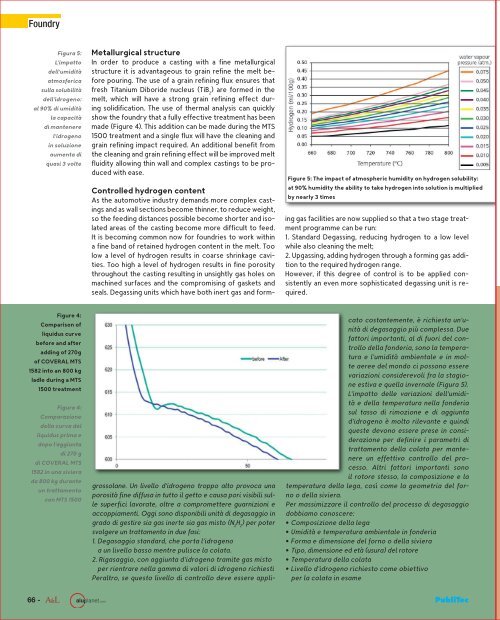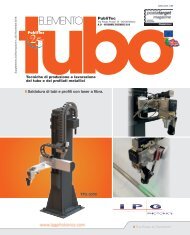sfogliabile_AL_n6_dicembre
Create successful ePaper yourself
Turn your PDF publications into a flip-book with our unique Google optimized e-Paper software.
Foundry<br />
Figura 5:<br />
L’impatto<br />
dell’umidità<br />
atmosferica<br />
sulla solubilità<br />
dell’idrogeno:<br />
al 90% di umidità<br />
la capacità<br />
di mantenere<br />
l’idrogeno<br />
in soluzione<br />
aumenta di<br />
quasi 3 volte<br />
Metallurgical structure<br />
In order to produce a casting with a fine metallurgical<br />
structure it is advantageous to grain refine the melt beforepouring.Theuseofagrainrefiningfluxensuresthat<br />
fresh Titanium Diboride nucleus (TiB 2<br />
)areformedinthe<br />
melt, which will have a strong grain refining effect during<br />
solidification. The use of thermal analysis can quickly<br />
show the foundry that a fully effective treatment has been<br />
made (Figure 4). This addition can be made during the MTS<br />
1500treatmentandasinglefluxwillhavethecleaningand<br />
grain refining impact required. An additional benefit from<br />
the cleaning and grain refining effect will be improved melt<br />
fluidity allowing thin wall and complex castings to be produced<br />
with ease.<br />
Figure5:Theimpactofatmospherichumidityonhydrogensolubility:<br />
at 90% humidity the ability to take hydrogen into solution is multiplied<br />
by nearly 3 times<br />
ing gas facilities are now supplied so that a two stage treatment<br />
programme can be run:<br />
1. Standard Degassing, reducing hydrogen to a low level<br />
while also cleaning the melt;<br />
2. Upgassing, adding hydrogen through a forming gas addition<br />
to the required hydrogen range.<br />
However, if this degree of control is to be applied consistently<br />
an even more sophisticated degassing unit is required.<br />
Figure 4:<br />
Comparison of<br />
liquidus curve<br />
before and after<br />
adding of 270g<br />
of COVER<strong>AL</strong> MTS<br />
1582 into an 800 kg<br />
ladle during a MTS<br />
1500 treatment<br />
Figura 4:<br />
Comparazione<br />
della curva del<br />
liquidus prima e<br />
dopo l’aggiunta<br />
di 270 g<br />
diCOVER<strong>AL</strong>MTS<br />
1582 in una siviera<br />
da 800 kg durante<br />
un trattamento<br />
con MTS 1500<br />
Controlled hydrogen content<br />
As the automotive industry demands more complex castings<br />
and as wall sections become thinner, to reduce weight,<br />
sothefeedingdistancespossiblebecomeshorterandisolated<br />
areas of the casting become more difficult to feed.<br />
Itisbecomingcommonnowforfoundriestoworkwithin<br />
afinebandofretainedhydrogencontentinthemelt.Too<br />
low a level of hydrogen results in coarse shrinkage cavities.<br />
Too high a level of hydrogen results in fine porosity<br />
throughout the casting resulting in unsightly gas holes on<br />
machined surfaces and the compromising of gaskets and<br />
seals. Degassing units which have both inert gas and formgrossolane.<br />
Un livello d’idrogeno troppo alto provoca una<br />
porosità fine diffusa in tutto il getto e causa pori visibili sulle<br />
superfici lavorate, oltre a compromettere guarnizioni e<br />
accoppiamenti. Oggi sono disponibili unità di degasaggio in<br />
gradodigestiresiagasinertesiagasmisto(N 2<br />
H 2<br />
)perpoter<br />
svolgere un trattamento in due fasi:<br />
1. Degasaggio standard, che porta l’idrogeno<br />
a un livello basso mentre pulisce la colata.<br />
2. Rigasaggio, con aggiunta d’idrogeno tramite gas misto<br />
per rientrare nella gamma di valori di idrogeno richiesti<br />
Peraltro, se questo livello di controllo deve essere applicato<br />
costantemente, è richiesta un’unità<br />
di degasaggio più complessa. Due<br />
fattoriimportanti,aldifuoridelcontrollo<br />
della fonderia, sono la temperatura<br />
e l’umidità ambientale e in molteaereedelmondocipossonoessere<br />
variazioni considerevoli fra la stagione<br />
estiva e quella invernale (Figura 5).<br />
L’impatto delle variazioni dell’umidità<br />
e della temperatura nella fonderia<br />
sul tasso di rimozione e di aggiunta<br />
d’idrogenoèmoltorilevanteequindi<br />
queste devono essere prese in considerazione<br />
per definire i parametri di<br />
trattamento della colata per mantenere<br />
un effettivo controllo del processo.<br />
Altri fattori importanti sono<br />
il rotore stesso, la composizione e la<br />
temperatura della lega, così come la geometria del forno<br />
o della siviera.<br />
Per massimizzare il controllo del processo di degasaggio<br />
dobbiamo conoscere:<br />
• Composizione della lega<br />
• Umidità e temperatura ambientale in fonderia<br />
• Forma e dimensione del forno o della siviera<br />
• Tipo,dimensioneedetà(usura)delrotore<br />
• Temperatura della colata<br />
• Livello d’idrogeno richiesto come obiettivo<br />
per la colata in esame<br />
66 -<br />
.com<br />
PubliTec





